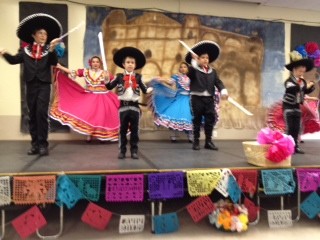
It might only be in the United States, or possibly Southern California, where one finds Caucasian, Vietnamese and Latino students dancing together to traditional, folkloric Mexican songs. The Eighth Annual “La Purisima Ballet Folklorico” at La Purisima Catholic School in Orange featured just that. In an evening performance, students — clad in traditional, multicolored Mexican dresses and suits — stomped their feet to several folkloric Mexican dances.
Traditionally, “Ballet Folkorico de Mexico” is a folkoric ballet troupe in Mexico city that showcases several dances in traditional costumes, reflecting and celebrating Mexican culture and heritage.
The evening production drew an audience of nearly 200 parents, staff and
faculty members. Marlene Earl's son, a kindergartener at the
elementary/junior high school, performed as a mini-charro.
]
“I like seeing a multiethnic group performing one culture's dance,” she
said. The school ensemble practiced for 10 weeks to perform dances from seven different regions —
Zacatecas, Oaxaca, Jalisco, Sinaloa, Chiapas, Yucatan, and
Veracruz.
Deborah A. Tejadilla, who produced and directed the 90-minute long
performance, flew to Guadalajara to purchase the different costumes for each
dance.
“Every button, ribbon and ruffle means something,” she said. “This
program is something that really evolved into a beautiful celebration of
children. It's promoting self-esteem and confidence, and getting to know Latino culture.”
Andrew Jimenez, a sixth-grader at La Purisima, performed in the ballet
folklorico for the past two years.
“It makes me feel like I'm at home when I'm on stage and I dance,” he
said. “My grandfather does it, and so I love to do it.” Jimenez performed in “Los Machetes” (the swords) from Jalisco (home of the
“Mariachi”) where he and his peers, wearing Spanish charro suits and
draped in rainbow-colored sarapes, danced while clapping their
aluminum-wrapped, cardboard swords together, syncing each bang to the
beat. They danced on stage to the backdrop of a large Spanish mission painting.
It was one of the beginning dances of the performance, followed by
“Moviendo Las Carderas,” (move your hips) where a group of 8th-grade girls danced to the Sinaloan traditional song with a modern
flair of tropical beats. The girls wore crimson red and black floral
dresses laced with gold ribbons.
In “Los Rebezos” (the shawls), another lively, Mariachi-styled,
acoustical tune from Jalisco, the students looked like a painter's
palette — they wore red, lime green, purple, black, lavender and orange dresses
with dainty red shawls wrapped across their shoulders as they ran across the
stage, stomping their black heels deliberately to a medley beat of
trumpets, acoustics and violins. Up next, La Purisima's Parish children
performed a folkloric dance from Chiapas, shaking their hand-held
maracas in sync with the percussive, upbeat rhythm of “Corazones
Alegres” (happy hearts).
In “Mujeres Que Se Pintan” (“The Women that Are Painted”), the
8th-grader girls performed a four-step in ankle-length white dresses
embroidered with bright blue, yellow and orange floral prints, while
daintily waving flower-laced fans to a combination of Mayan-influenced,
Spanish folkloric tunes.
The evening ended with all students performing to the famous, festive
and tropical dance of “La Bamba” from Veracruz, a region in Eastern
Mexico. The boys changed from black Charro suits to white guabayera
shirts and pants with red bandanas underneath straw hats. Afterwards, Tejadilla awarded the
students with certificates for their participation in the after school
program.
“Everyone is a superstar in folklorico,” Tejadilla said. “You don't know
who the honor roll kid is or the outcast or misfit. All the barriers
are dropped and everyone becomes a superstar.”
Like Heard Mentality on Facebook and follow us on Twitter at @ocweeklymusic!

